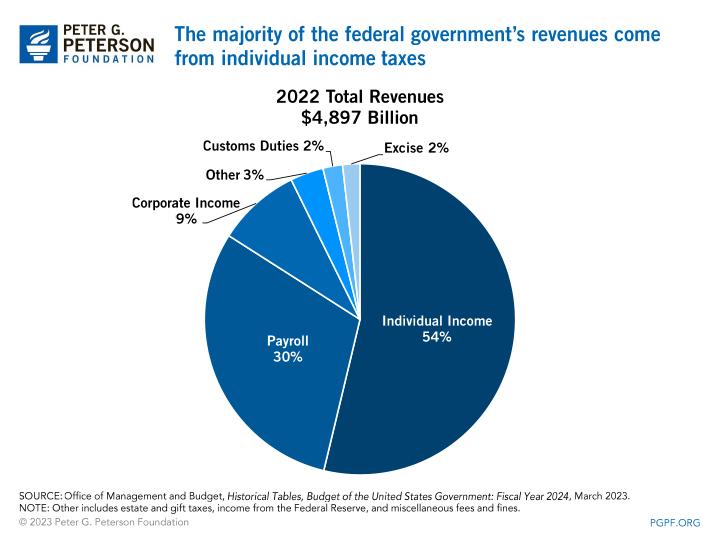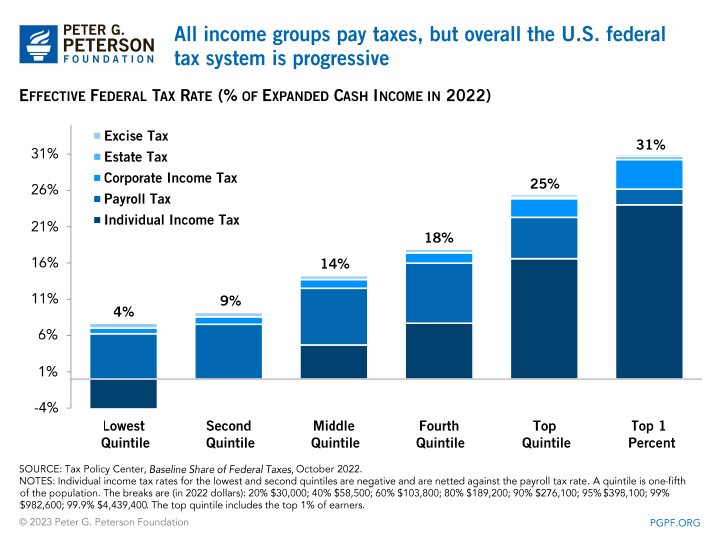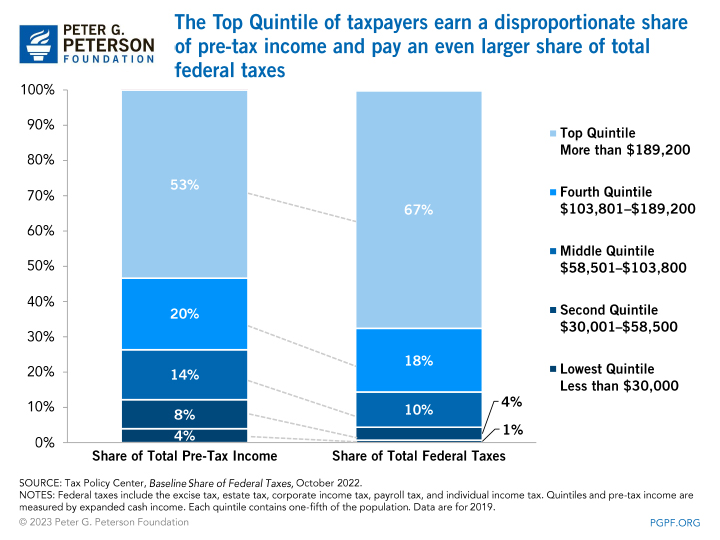You are here
The fairness of our federal tax system is a hotly debated issue. Too often, however, those debates confuse or misrepresent important facts because they focus on one type of tax in isolation rather than the various taxes that people face in aggregate. Using 2022 data from the Tax Policy Center (TPC) and the Congressional Budget Office (CBO), to reflect a typical year before the COVID pandemic, we can examine the broader federal tax system.
Americans Pay Many Types of Taxes
The federal government collects revenues from a variety of sources such as:
- Individual income taxes – the largest source of tax revenues and half of total annual receipts. Income taxes are levies on wages and salaries, income from investments, and other income.
- Payroll taxes, which help to finance Social Security, Medicare, and unemployment benefits, are the second-largest source of federal revenues and make up about one-third of total receipts annually. Payroll taxes are deducted from workers' paychecks through a line item called FICA, which stands for the Federal Insurance Contributions Act.
- The government also collects taxes on the profits of corporations. In 2021, the effective corporate tax rate at the federal level was 20 percent
- Excise taxes are indirect levies upon transactions of particular goods or activities, such as gasoline, alcohol, or gambling.
- Customs duties are taxes imposed on specific imported goods.
- Other sources include estate and gift taxes and payments to the Federal Reserve.

While nearly all Americans pay taxes, the composition of the type of taxes paid is very different for taxpayers at various points in the income distribution. Affluent Americans pay a larger share of their income in individual income taxes, corporate taxes, and estate taxes than do lower-income groups.1 By contrast, lower-income groups owe a greater portion of their earnings for payroll and excise taxes than those who are better off. In fact, taxpayers whose incomes are in the bottom 80 percent of all incomes pay, on average, more in payroll taxes than in income taxes.

The U.S. Tax System Is Progressive
As a whole, the U.S. tax code remains progressive — with higher-income taxpayers paying a greater share of their income in taxes. That is true despite the fact that high-income Americans benefit disproportionately from tax breaks, otherwise known as tax expenditures.
Major tax expenditures — such as lower rates on capital gains and dividends, deductions for charitable contributions, and deductions for state and local taxes — tend to benefit higher-income taxpayers more than lower-income groups. CBO estimates that the top quintile of taxpayers receive 44 percent of the value of major tax expenditures, while only 11 percent goes to the bottom two quintiles. However, even with substantial tax expenditures, the top one percent of American taxpayers still pay an effective tax rate of 31 percent, on average, while the bottom 20 percent of the population pay an average of 4 percent.
TPC estimates that 67 percent of taxes collected for 2022 came from those in the top quintile, or those earning an income above $189,200 annually. Within this group, the top one percent of income earners — those earning more than $982,600 per year — will contribute 26 percent of all federal revenues collected.

While the fairness of the tax system is much debated, many economists agree that simplifying the tax code would help the economy. Further tax reform could promote economic growth while also making the code more simple, transparent, and fair.
1 The corporate income tax affects individuals by reducing wages and returns to capital. Based on economic research, TPC attributes 80% of the corporate-tax burden to capital and 20% to wages and other sources of labor income.
